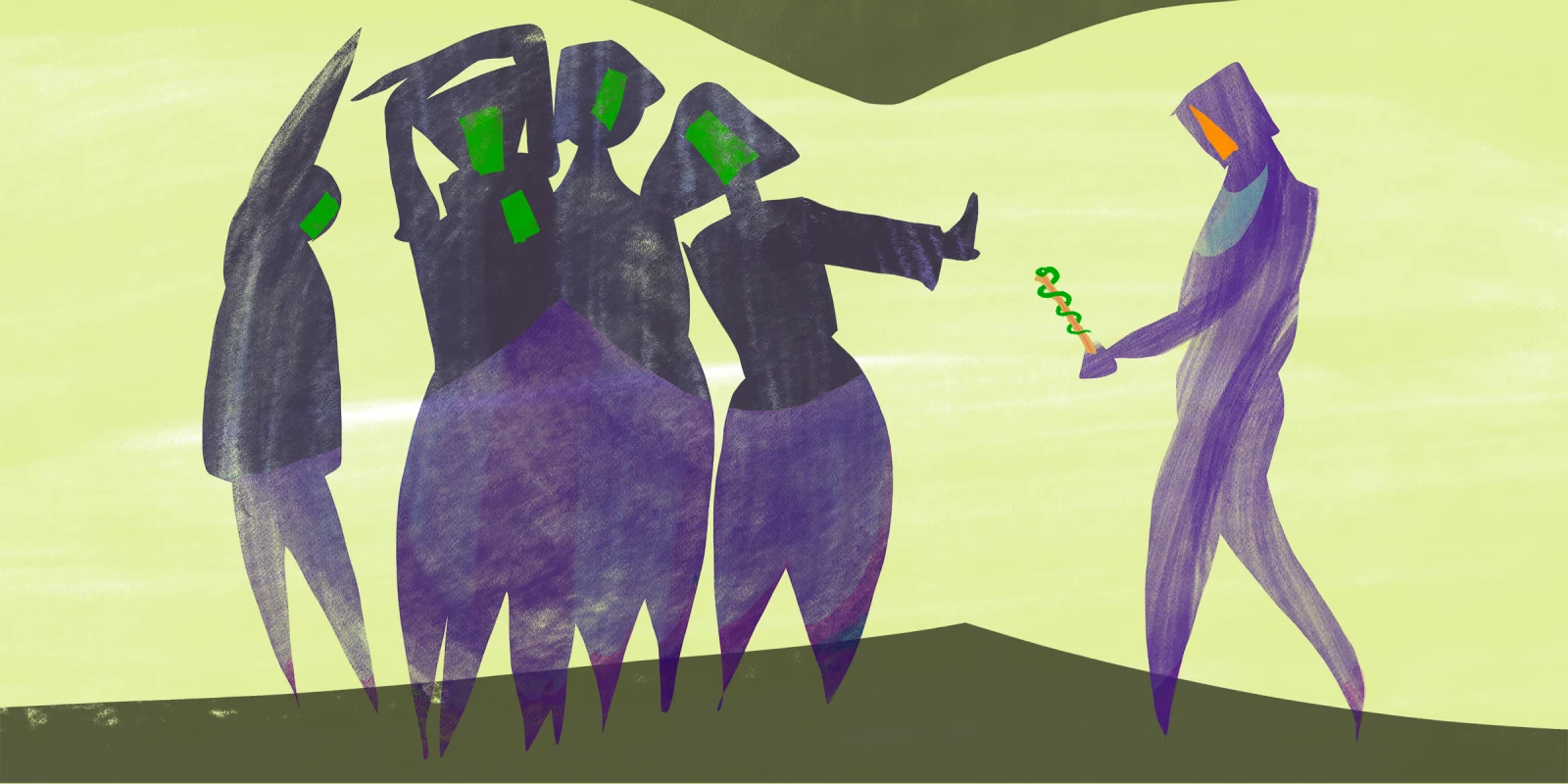Each year, more than 30,000 graduating medical students encounter a crucial box on their ERAS for the main residency Match — member or non-member of the Alpha Omega Alpha (AOA) Honor Medical Society. Being a member signifies academic prowess, strong leadership, and excellent clinical performance. Or does it?
Founded in 1902, the AOA consists of more than 200,000 medical student and physician members across 135 chapters. Its mission is to recognize high educational achievement, grounded in the motto to “be worthy to serve the suffering,” as said by its founder, Dr. William Root.
A closer look reveals another reality: AOA membership is disproportionately white. A 2017 cohort study of 4,655 medical students illustrated that AOA membership for white students was nearly six times greater than that for Black students and nearly two times greater than that for Asian students. Another 2019 cohort study examined data from 11,781 ERAS applications and found that Black students were significantly less likely to be inducted into the AOA compared to other groups. Additionally, exclusion from AOA membership also disproportionately impacted Hispanic/Latinx, American Indian/Alaska Native, and Native Hawaiian/Pacific Islander students.
These inequities are especially concerning given the differential access AOA membership affords. AOA members are prioritized for interview invites, have greater odds of matching into traditionally competitive specialties, and experience access to a vast array of subsequent career opportunities. According to 2018 NRMP data, AOA members comprise 40% of the residents in highly competitive specialties (i.e., dermatology, plastic surgery, orthopaedic surgery, urology, radiation oncology, and otolaryngology). This honorary designation and rubber-stamping of excellence can amplify success over the course of one’s career through exclusive mentorship, networking, grant funding, and research opportunities. Unsurprisingly, 75% of medical school deans are members of the AOA, as indicated by the organization’s website.
Inequities in AOA membership go far beyond the issue of diverse representation. Medical students of color tend to receive lower clerkship grades compared to their white counterparts, particularly those who are underrepresented in medicine (URIM), even after controlling for test scores. In clinical evaluations, white medical students have a greater propensity to be characterized by their professional attributes such as “knowledgeable,” while Black students are more likely to be described by personal characteristics like “pleasant.” While these grading trends are concerning, they are only part of a greater whole.
Through various processes such as activation via triggers, internal dialogue, and threat response, URIM students undergo additional burden and energy expenditure that non-URIM students do not experience. Minoritized students face more negative perceptions in their learning environments, difficulty finding peer support networks, trouble establishing peer-working relationships, and experiences of racism within their institutions. Moreover, URIM trainees are often expected to lead diversity, equity, and inclusion efforts at their institutions without financial or academic compensation, which can detract from academic and clinical duties. Faculty may not represent the demographic diversity of the student population and patients they serve, which may exacerbate students' risk of stereotype threat, negatively impacting their experiences and perceived performances. This confluence of factors leads to minority taxation, contributing to impaired performance and poorer clerkship grades. Given that AOA selection is based largely on grades, it serves as an exclusionary mechanism that is magnified in later stages of training, a phenomenon Teherani and colleagues coined “amplification cascade.”
While the AOA was founded on the premise of service, it has contributed to a racist structure that continues to minoritize and marginalize trainees of color. Given the growing evidence of systemic exclusion of minoritized students from the AOA, we believe that disaffiliation from this organization is an important step in addressing structural racism in medical education.
Multiple institutions have disaffiliated from the AOA, including the UCSF School of Medicine, the Yale School of Medicine, and the Icahn School of Medicine at Mount Sinai. At the time of this writing, the institutions affiliated with the authors of this piece (David Geffen School of Medicine at UC Los Angeles and UC Davis School of Medicine) have issued moratoriums on AOA considerations, pending further investigation of inequities seen in AOA membership and input from students, faculty, and other stakeholders. Institutions including Harvard, Yale, and Mayo Clinic have never had AOA chapters.
One of the authors of this piece is a third-year resident member of the AOA, and the other author is a first-year resident whose medical school did not offer AOA membership. As medical professionals at distinct points of the medical practice and training continuum, we recognize that medical schools may be reluctant to forgo the opportunity to recognize high achievement in a select group of students. However, we believe that the AOA’s narrow definition of excellence with an overreliance on traditional metrics of “achievement,” as well as biased clinical assessment and grades, perpetuate legacies of systemic inequities embedded within our educational infrastructure.
Disaffiliation entails eliminating institutional ties to the AOA national organization. From a practical standpoint, disaffiliated institutions would no longer be displayed as chapters on published materials by the AOA. Additionally, medical students from these institutions would not have access to the exclusive benefits the organization provides. Residency applicants would select “no AOA chapter at my school” under the ERAS awards section. Certainly, the drawback of not accessing the network and resources provided by the AOA is worth considering. However, eliminating this flawed metric would protect medical students of color from the exclusionary impacts of AOA deselection. Furthermore, it would compel genuine steps toward holistic review of applicants, which is critical to promoting equity in admissions and medical education at large.
Medical schools that have disaffiliated continue to analyze the resultant benefits. For example, the UCSF School of Medicine states that the benefits include a greater emphasis on learning and student wellness, as a focus on grades limits educational experiences as well as intellectual curiosity. For the Icahn School of Medicine at Mount Sinai, advantages of disaffiliation include “creating a more equitable learning environment for all students, removing the stress of competing for AOA, and making an important statement about academic culture and expectations.” The medical education leadership team at the Icahn School of Medicine at Mount Sinai concluded that “equity and wellness in medical education are more important than achievement and competition and that the benefits of withdrawing from AOA outweighed the risks.”
Why disaffiliate from and not simply reform the AOA? In 2020, the AOA evolved eligibility criteria to promote diversity by increasing the number of members per class and by allowing chapters to develop their own metrics. While the underlying intent of these changes is commendable, they fail to address the structural issues perpetuated by the AOA. Although individual institutions are allowed to develop their own metrics to be more inclusive, there is no objective measure nor formal entity holding these institutions accountable for enacting real change. Attempting to quantify and designate points for URIM status oversimplifies the lived experience of minoritized trainees, reinforces their tokenization, and perpetuates a narrative that discounts their accomplishments.
Furthermore, medical education need not preserve the hierarchy reinforced by the AOA. The organization’s original purpose was to escalate the standards of medical education and incentivize scholarship in an antiquated environment where students matriculated based upon wealth and nepotism in lieu of merit. In today’s highly competitive medical education landscape, schools are now universally saturated with qualified and conscientious students deserving entry into our noble profession. In addition, AOA, by definition, is a normative evaluation system which stands in direct contrast to medical education trends favoring objective, competency-based evaluation and assessment. While many wish to preserve medicine’s longstanding tradition of celebrating “excellence” in learners, it is this social construct of a hierarchy that historically has been leveraged to justify racism and exploit communities of color. Dissolving this power structure would be one meaningful step toward transforming the medical education landscape from elitist to equitable.
Institutional affiliation with the AOA perpetuates a flawed system that disproportionately benefits privileged trainees while excluding those that do not fit the socially dominant mold. This is diametrically opposed to justice, equity, and medicine’s oath to “Do no harm.” Terminating an institution’s local chapter, or “disaffiliating” from the national AOA organization, sends a compelling message. Medical education needs alternative, equitable mechanisms to recognize the excellence of trainees, and graduate medical training programs must adopt holistic review processes that consider the structural and contextual factors shaping applicants’ accomplishments. Moreover, disaffiliation is an effective means by which physicians and trainees alike can serve as national leaders on this issue as well as inspire other institutions to follow. We urge medical students, residents, fellows, and faculty to collaborate in disaffiliating their institutions from the AOA as one tangible, antiracist step to advancing equity in medicine.
The authors report no conflicts of interest.
Illustration by Jennifer Bogartz






